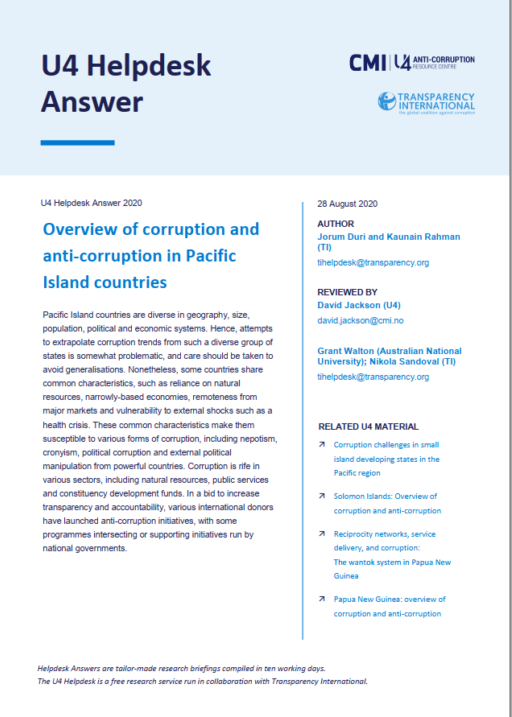- Home
- Anti-Corruption Helpdesk
- Overview of corruption and anti-corruption in Pacific Island countries
Overview of corruption and anti-corruption in Pacific Island countries

This Anti-Corruption Helpdesk brief was produced in response to a query from a U4 Partner Agency. The U4 Helpdesk is operated by Transparency International in collaboration with the U4 Anti-Corruption Resource Centre based at the Chr. Michelsen Institute.
Query
Please provide an overview of corruption and anti-corruption in the Pacific region. What are the anti-corruption programmes by donors in the Pacific Island countries, and which programmes are achieving the best outcomes? Our main interest is on the Melanesian countries (PNG, Fiji, Solomon Islands, Vanuatu), the microstates (Kiribati, Tuvalu, Nauru), Samoa and Tonga.
Summary
Pacific Island countries are diverse in geography, size, population, political and economic systems. Hence, attempts to extrapolate corruption trends from such a diverse group of states is somewhat problematic, and care should be taken to avoid generalisations. Nonetheless, some countries share common characteristics, such as reliance on natural resources, narrowly-based economies, remoteness from major markets and vulnerability to external shocks such as a health crisis. These common characteristics make them susceptible to various forms of corruption, including nepotism, cronyism, political corruption and external political manipulation from powerful countries. Corruption is rife in various sectors, including natural resources, public services and constituency development funds. In a bid to increase transparency and accountability, various international donors have launched anti-corruption initiatives, with some programmes intersecting or supporting initiatives run by national governments.
Contents
- Background and regional trends
- Country profiles
a. Papua New Guinea
b. Fiji
c. Solomon Islands
d. Vanuatu
e. Kiribati
f. Tuvalu
g. Nauru
h. Samoa
i. Tonga
3. Anti-corruption programmes by donors
4. Annex: regional overview of governance performance
5. References
Main points
- Some Pacific Island countries do not appear on several governance indicators, making it difficult to fully understand the extent of corruption in the region.
- There is great diversity across the Pacific Island countries, in areas such as geography, size, culture, economies and political systems. However, many countries do share a set of common characteristics that affect governance issues and result in common forms of corruption, including bribery, nepotism, cronyism and political corruption.
- Corruption is rife in various sectors, including natural resource management, public services and constituency development funds.
- All countries have criminalised most corruption offences and have ratified UNCAC, with Tonga becoming the latest member state from the region after its ratification earlier this year.
- Anti-corruption programmes by donors usually intersect or support initiatives by national governments.
Authors
Jorum Duri and Kaunain Rahman, [email protected]
Reviewers
David Jackson (U4 Anti-Corruption Resource Centre)
Grant Walton (Australian National University) and Nikola Sandoval (Transparency International)
Date
09/11/2020
Tags
 Download PDF
Download PDF
